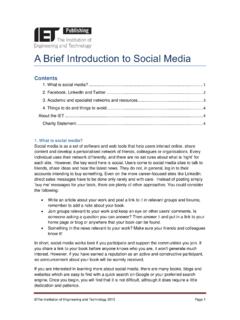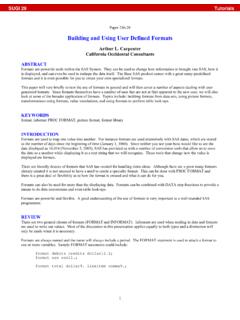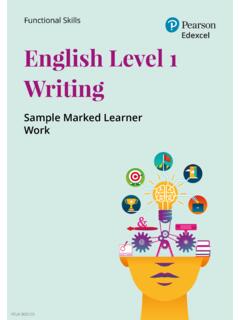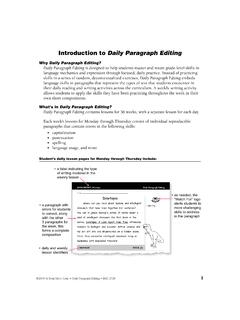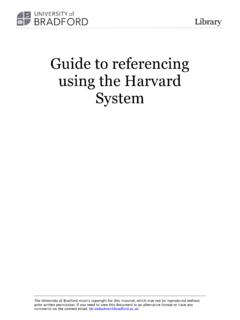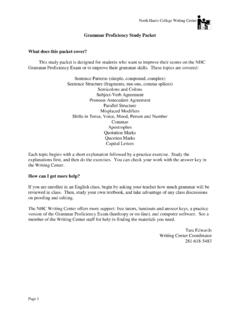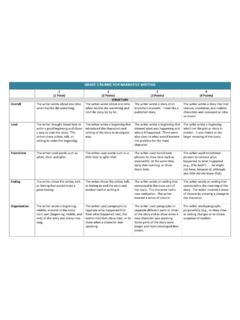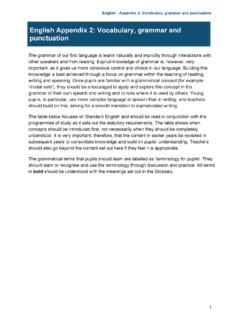Transcription of A guide to technical report writing
1 A guide to technicalreport writingA guide to technical report writing Contents02 Contents1. What makes a good technical report ? 32. Objectives 4 Who are you producing the report for? 43. Format 5 Appendices 5 Sections and subsections 5 References 64.
2 writing 7 Spelling 7 Punctuation 7 Sentences 7 Paragraphs 8 Formality 8 Example 85.
3 Diagrams 9 Positioning 9 Tables 9 Graphs 9 Diagram references 96.
4 Finishing the report 10 Summaries 10 Abstracts 10 Table of contents 10 Title page 10 Appearance 10 Checking 107.
5 Resources 111. What makes a good technical report ?A good report is easy to recognise. Its title is precise and informative and its format logical to the reader, with headings to indicate the content of each section. Diagrams are well-presented and clearly labelled. There are no absolute rules on report production because every report must be adapted to the needs of its reader. This guide , however, suggests that there are laws of good report writing which should be generally applied (but broken if necessary). Keep these rules in mind and you will be more likely to attract readers, direct them towards relevant, clear information and steer them towards the desired response.
6 Notice that the first law is repeated because it s a law which shouldn t be broken. Taking shortcuts to save time and money are counterproductive if your reader is left confused by the report or decides it s too difficult to work out what you are trying to guide to technical report writing What makes a good technical report ?0310 laws of good report writing1. produce the report for your reader(s)2. keep the report as short as possible3. organise information for the convenience of the reader4. include accurate references5. ensure your writing is accurate, concise and straightforward6. include diagrams with the right labels in the right place for your reader7. make sure your summary gives the whole picture in brief8.
7 Check the report for technical errors, typing errors and inconsistency9. consider design as well as content10. produce the report for your reader(s)A guide to technical report writing was originally written by Joan van Emden and the late Jennifer Eastel and has been revised by the IET, with input from Alex Kerr who delivers this course on behalf of the the objectives for your report before you start writing . Note them down and check that you are keeping to them, even during the last stages of production. Your objectives should identify: who you re producing the report for why you re producing the report what information you re Who are you producing the report for?If you want your report to make an impact, you need to consider your reader.
8 Knowing your reader should determine your approach, the technical content and style of your writing . Ask yourself: What does the reader already know about the subject? What do you need to tell the reader? Why does a particular reader need this particular report ? What is the desired response from the reader? How can you bridge the gap between what the reader knows already and what they need to know, in order to produce the desired response? What level of formality is appropriate? ( a short emailed report to a colleague will be less formal than a report for a managing director of another company)Reports are often written for multiple readers, for example, technical and financial managers. writing two separate reports would be time-consuming and risk offending people who are not party to all of the information.
9 One solution to this problem is strategic use of appendices (see page 5).A guide to technical report writing Objectives042. ObjectivesWhat happens without clear objectivesIf you don t take time to clarify your objectives, writing the report will be more difficult, understanding it even more so and you may not achieve the desired report which was meant to cover the UK, but instead just dealt with England and Wales resulted in lost opportunities for development and sales in Scotland and Northern report which tried to be both a specification of a machine and a report on the results of using a machine left readers in confusion, as it didn t provide a precise specification or a satisfactory FormatOnce the objectives have been established, start organising the information available.
10 As you find material, put it into one of three categories:1. important information that is relevant to the objectives2. borderline information which might be useful to some readers or support more important material3. information which may be interesting to you, but is not relevant to the objectivesSet aside category 3 material to check it later. Material in categories 1 and 2 must be kept available and thought of as probable main text (category 1) and appendix material (category 2). When you ve identified probable main text, you can start looking through it to decide on how it could be ordered logically. AppendicesAlthough appendices are at the end of a report , think about them first as they can be one your most useful tools.


